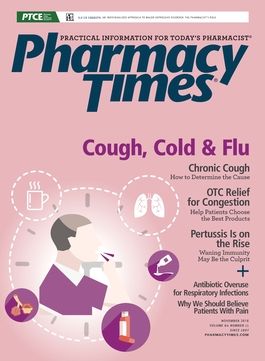Publication
Article
Pharmacy Times
Antibiotic Overuse for Respiratory Infections Can Be a Danger to Society
Author(s):
An acute respiratory tract infection is a common reason to seek medical attention.
An acute respiratory tract infection is a common reason to seek medical attention. Although most respiratory tract infections are caused by a virus, such as influenza, respiratory syncytial virus, or rhinovirus, antibiotics are often overprescribed for these infections.1
The past few decades have seen a decline in office visits resulting in antibiotic prescriptions, yet the overuse of antibiotics is still a problem.2 This decline has primarily affected antibiotic overuse in children; adults continue to be prescribed unnecessary antibiotics. The overuse of antibiotics is expensive, promotes resistance, and can lead to harmful adverse events.2
In addition, the use of broad-spectrum antibiotics surpasses the use of the more judicious narrow-spectrum antibiotics, especially macrolides and fluoroquinolones.2 This is problematic, as the overuse of broad-spectrum agents contributes to the development of antibiotic-resistant microbes much more so than do narrow-spectrum agents.2,3
Bactericidal Versus Bacteriostatic?
Professionals in the medical field have widely accepted that the continued use of any antibacterial or class of antibacterial will ultimately result in either the development of resistance to these agents or new microbes that are intrinsically resistant to the agent.3 To keep this in check, practitioners should select antibiotic agents based on susceptibility and in doses high enough to be bactericidal.3
If these microbes are killed, as opposed to inhibited, mutations that exist or may occur under the discerning pressure of the antimicrobial agent are not likely to be disseminated.3
Clinicians’ Concerns
Interventions to promote judicial use of antibacterial agents by targeting both patients and physicians have been somewhat successful, but there are factors that inhibit the effectiveness of these interventions.
Patient pressure often leads to the overuse of antibiotic agents.4 The majority of patients report an expectation of an antibacterial agent when they experience discolored nasal discharge.5 In addition, it is estimated that patients expecting a prescription are 3 times more likely than patients not expecting a prescription to get one.5
Clinicians are also often concerned that if they do not provide a prescription, patients will feel dissatisfied with the medical care that they received and will seek help elsewhere.5 This is known as the chagrin factor.5 However, it has been shown that patient satisfaction has more to do with the patient-centered quality of the office visit, such as the amount of time spent with the patient and the discussion of the illness, than with the receipt of an antibiotic prescription.4,5
Changing Beliefs and Behaviors
Clinicians can increase patient satisfaction as well as reduce antibacterial agents by changing their terminology. For example, bronchitis can be labeled as a chest cold or a viral respiratory infection.
Practice partners need to put in place a protocol for providing antibiotic prescriptions, and everyone should follow that protocol. If just 1 clinician liberally distributes prescriptions for antibacterial agents and the rest use a judicial protocol, the efforts of the rest will be undermined.5
A patient-centered interview is key to both preserving the clinician—patient relationship and reducing overuse of antibacterial agents. A patient-centered interview should include a thorough exploration of what the patient thinks is wrong, the patient’s feelings (especially fear) about their problem, their expectations of the physician, and the effect of the illness on functioning.5
Medical assistants and triage nurses are tasked with returning calls and addressing patient concerns. Therefore, a thorough understanding of the evidence behind antibiotic-use recommendations, as well as the reasons behind the use of medications to treat symptoms as opposed to antibiotic therapy, is key.5
Conclusion
Large-scale reduction of antibiotic prescriptions requires a multidimensional approach. Clinician and patient education is vital.
Although everyone on the health care team is responsible for appropriate use of antibiotics, only clinicians control the prescriptions.4 Appropriate antibiotic prescription decreases health care costs, improves quality of care, and preserves antibacterial agent integrity.4
Kathleen Kenny, PharmD, RPh, earned her PharmD from the University of Colorado Health Sciences Center in Aurora. She has more than 25 years of experience as a community pharmacist and is a freelance clinical medical writer based in Colorado Springs, Colorado.
References
- Tillekeratne LG, Bodinayake CK, Dabrera T, et al. Antibiotic overuse for acute respiratory tract infections in Sri Lanka: a qualitative study of outpatients and their physicians. BMC Fam Pract. 2017;18(1):37. doi 10.1186/s12875-017-0619-z.
- Shapiro DJ, Hicks LA, Pavia AT, Hersh AL. Antibiotic prescribing for adults in ambulatory care in the USA, 2007-09. J Antimicrob Chemother. 2014;69(1):234-340. doi 10.1093/jac/dkt301.
- Stratton CW. Dead bugs don’t mutate: susceptibility issues in the emergence of bacterial resistance. Emerg Infect Dis. 2003;9(1):10-16. doi: 10.3201/eid0901.020172.
- Harris AM, Hicks LA, Qaseem A. Appropriate antibiotic use for acute respiratory tract infections in adults. Ann Inter Med. 2016;165(9):674. doi: 10.7326/L16-0284.
- Fagnan LJ. Prescribing antibiotics for upper respiratory infections. J Fam Pract. 2000;49(5):415-417.







